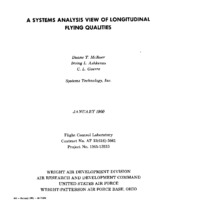-
Title
-
A System Analysis View Of Longitudinal Flying Qualities
-
Description
-
The application of servo analysis methods to the study of handling qualities problems provides a unifying framework for requirements which hitherto were apparently diverse and unrelated. The technique is also effective in delineating possible difficulties, and solutions thereto, for the as yet experimentally unexplored regions associated with modern and future vehicles and environments. The research reported is a study of longitudinal handling qualities, in this servo context, which makes substantial progress toward evolving an analytical method for specifying handling qualities requirements. Criteria and procedures are established for estimating both pilot dynamic behavior and opinion. Vehicle-pilot system studies utilizing this pilot model predict the influence of variations in the magnitude and/or the relative location of the poles and zeros in the vehicle transfer function. Where experimental observations on such influences exist, they appear to be reasonably consistent with the analytical predictions. Where they do not, the predictions identify new parameters of possible significance and serve as an interim basis for design and a guide to future testing.
-
Date
-
1960
-
Index Abstract
-
Contrails only
-
Photo Quality
-
Not Needed
-
Report Number
-
WADD TR 60-43
-
Creator
-
McRuer, Duane T.
-
Ashkenas, Irving L.
-
Guerre, C. L
-
Corporate Author
-
Systems Technology, Inc.
-
Laboratory
-
Flight Control Laboratory
-
Extent
-
120
-
PB Number
-
PB171551
-
Identifier
-
AD0249386
-
AD0249386
-
Access Rights
-
OTS
-
Distribution Classification
-
1
-
Contract
-
AF 33(616)-5661
-
DoD Project
-
1365
-
DoD Task
-
13553
-
DTIC Record Exists
-
No
-
Distribution Change Authority Correspondence
-
WASS NOTICE
-
Report Availability
-
Full text available
-
Date Issued
-
1960-01
-
Abstract
-
The application of servo analysis methods to the study of handling qualities problems provides a unifying framework for requirements which hitherto were apparently diverse and unrelated. The technique is also effective in delineating possible difficulties, and solutions thereto, for the as yet experimentally unexplored regions associated with modern and future vehicles and environments. The research reported is a study of longitudinal handling qualities, in this servo context, which makes substantial progress toward evolving an analytical method for specifying handling qualities requirements. Criteria and procedures are established for estimating both pilot dynamic behavior and opinion. Vehicle-pilot system studies utilizing this pilot model predict the influence of variations in the magnitude and/or the relative location of the poles and zeros in the vehicle transfer function. Where experimental observations on such influences exist, they appear to be reasonably consistent with the analytical predictions. Where they do not, the predictions identify new parameters of possible significance and serve as an interim basis for design and a guide to future testing.
-
Provenance
-
IIT
-
Type
-
report
-
Format
-
1 online resource (xii, 108 pages) ill.
-
Subject
-
Aerodynamic Characteristics
-
Control Systems
-
Human Factors Engineering
-
Pilots
-
Pitch (Motion)
-
Aerodynamic Configurations
-
Aircraft
-
Airframes
-
Flight Simulators
-
Handling
-
Mathematical Analysis
-
Oscillation
-
Servomechanisms
-
Stability
-
Publisher
-
Wright-Patterson Air Force Base, OH : Wright Air Development Division, Air Research and Development Command, United States Air Force
-
Distribution Conflict
-
No
 WADDTR60-043.pdf
WADDTR60-043.pdf